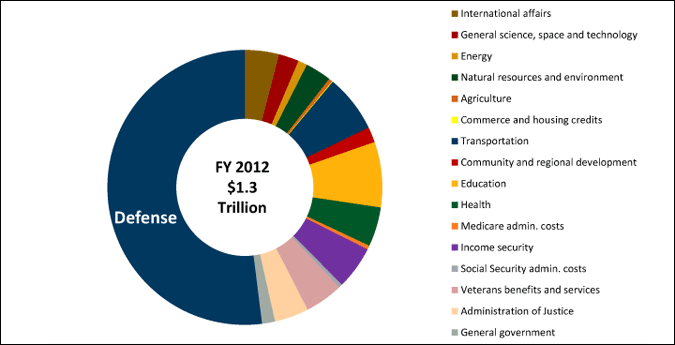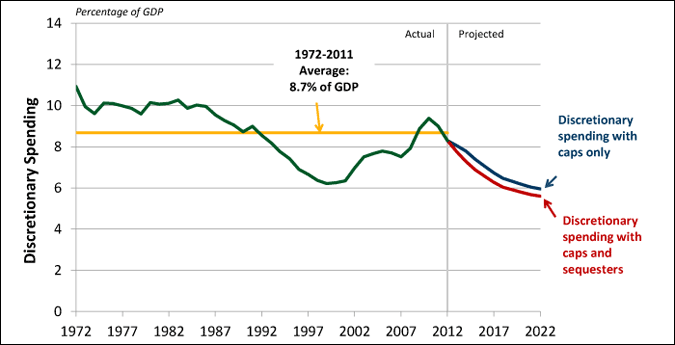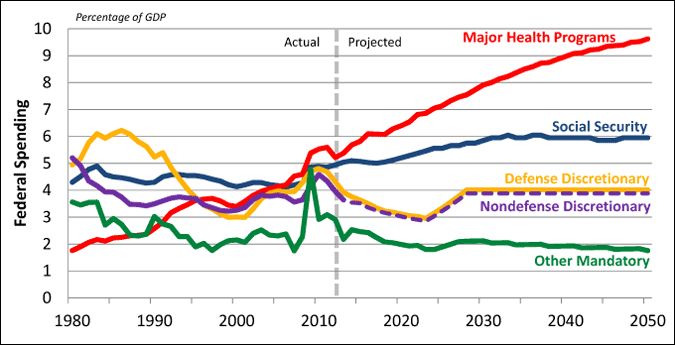You are here
Budget Explainer: What's at Stake with Discretionary Spending Cuts
In fiscal year 2012, the federal government spent almost $3.6 trillion, and about one-third of that amount was for "discretionary" programs. These programs cover a large number of government activities — everything from national defense to the FBI, highways, national parks, maintenance of the U.S. Capitol, and the National Academy of Sciences. Indeed most of the things that people consider to be federal government activities are funded through discretionary programs.
Discretionary spending funds a wide range of government programs

SOURCE: Data from the Congressional Budget Office, The Budget and Economic Outlook: Fiscal Years 2012 to 2022, January 2012. Compiled by PGPF.
This part of the budget is called "discretionary" because each year the Congress must vote on, and the president must sign, appropriation bills that provide funding for these programs. By contrast, no annual votes are required to fund so-called "mandatory" programs, the largest of which are Social Security and Medicare. Funding for these programs is on auto-pilot unless policymakers change the law. Spending on these programs is scheduled to grow as the population ages and the cost of health care increases.
Unlike mandatory spending, which is growing as a share of all federal spending, discretionary spending is declining as a share of the federal budget. Under current law, the Congressional Budget Office (CBO) projected that discretionary spending will grow by about $200 billion over the next decade. By contrast, mandatory spending will grow by an estimated $1.5 trillion over the same period. Because discretionary spending contributes so little to future spending growth, policymakers seeking to control our long-term debts will need to look beyond discretionary spending, and focus on the core drivers of our structural deficits — the health and retirement programs whose costs will soar as the baby boomers retire and health costs continue to grow, and a tax system that does not bring in enough revenue.
Discretionary spending and recent efforts to reduce the deficit
Discretionary spending has been a favorite target of policymakers concerned with cutting the deficit and reigning in debt growth. The latest example is the Budget Control Act of 2011 (BCA), which imposed caps that will cut about $760 billion in budgetary resources between 2012 and 2021.
The BCA also created the Joint Select Committee on Deficit Reduction, widely referred to as the "Supercommittee." The Supercommittee was a bipartisan, bicameral committee charged with developing a budget package that would reduce deficits by an additional $1.5 trillion over the ten years. Because the Supercommittee failed to reach agreement by its November 2011 deadline, the law now requires further reductions in spending at the beginning of 2013. These cuts, achieved through reductions in spending caps and a process known as sequestration, will fall heavily on discretionary spending and most heavily on discretionary defense spending. These cuts will push discretionary spending to a historically low level.
Because of these BCA provisions, discretionary spending is projected to decline from 8.3 percent of gross domestic product (GDP) in 2012 to an estimated 5.6 percent of GDP in 2022. At that level, discretionary spending will be lower than its lowest level in more than 40 years — and well below its average of about 8.7 percent of GDP between 1970 and 2011. These numbers raise serious questions about whether reducing discretionary spending to such a low level, almost 36 percent below its historical average, is either desirable or feasible.
To be sure, those low numbers assume that policymakers allow all of the automatic cuts to take place. But even if the cuts are overridden by Congress, discretionary spending will still only be about 6 percent of GDP in 2022, which is 30 percent below the 40-year average of discretionary spending.
Discretionary spending is projected to go well below historical levels under current law

SOURCE: Data from the Congressional Budget Office, An Update to the Budget and Economic Outlook: Fiscal Years 2012 to 2022, August 2012; and The Budget and Economic Outlook: Fiscal Years 2013 to 2022, January 2012. Compiled by PGPF.
Not surprisingly, both the CBO and the Government Accountability Office (GAO) assume in their long-term projections that discretionary spending will return to its historical average of 8.7 percent of GDP by the middle of the 2020s.
Discretionary spending reductions do little to slow long-run growth in debt
Although the BCA sharply limited the growth of discretionary spending, the long-term outlook for debt has not changed much since the BCA was enacted. In 2011 — before the BCA — CBO projected that federal debt would climb to 187 percent of GDP by 2035 under current policies. In 2012 — after BCA was enacted — CBO projected that debt would climb to 180 percent of GDP by 2035 and 190 percent of GDP by 2036. In other words, the passage of the BCA with its sharp reductions in discretionary spending buys only a year before debt surpasses 190 percent of GDP.
The reason for these disappointing results is simple: discretionary spending does not drive long-term spending growth in the federal budget. As can be seen in the chart below, the federal government's big health programs — Medicare and Medicaid — and, to a lesser extent, Social Security account for 100 percent of the growth in noninterest spending going forward.
Health care is the major driver of the projected federal spending growth over the long term

SOURCE: Peter G. Peterson Foundation current policy projections based upon Congressional Budget Office, The 2012 Long-Term Budget Outlook, June 2012. Assumes that the automatic reductions specified in the BCA do not take effect and that discretionary spending gradually returns to 7.9 percent of GDP after 2022.
Putting the Budget on a Sustainable Path
The only way to control debt growth and reduce deficits in the long term is to go beyond discretionary spending. On the spending side of the budget, solutions will have to address health programs such as Medicare and Medicaid that grow faster than the economy and Social Security, which will place more pressure on the budget as the baby boomers retire. On the revenue side, solutions are needed that fix our tax system so it generates sufficient revenue to pay for the government programs that the public wants.
